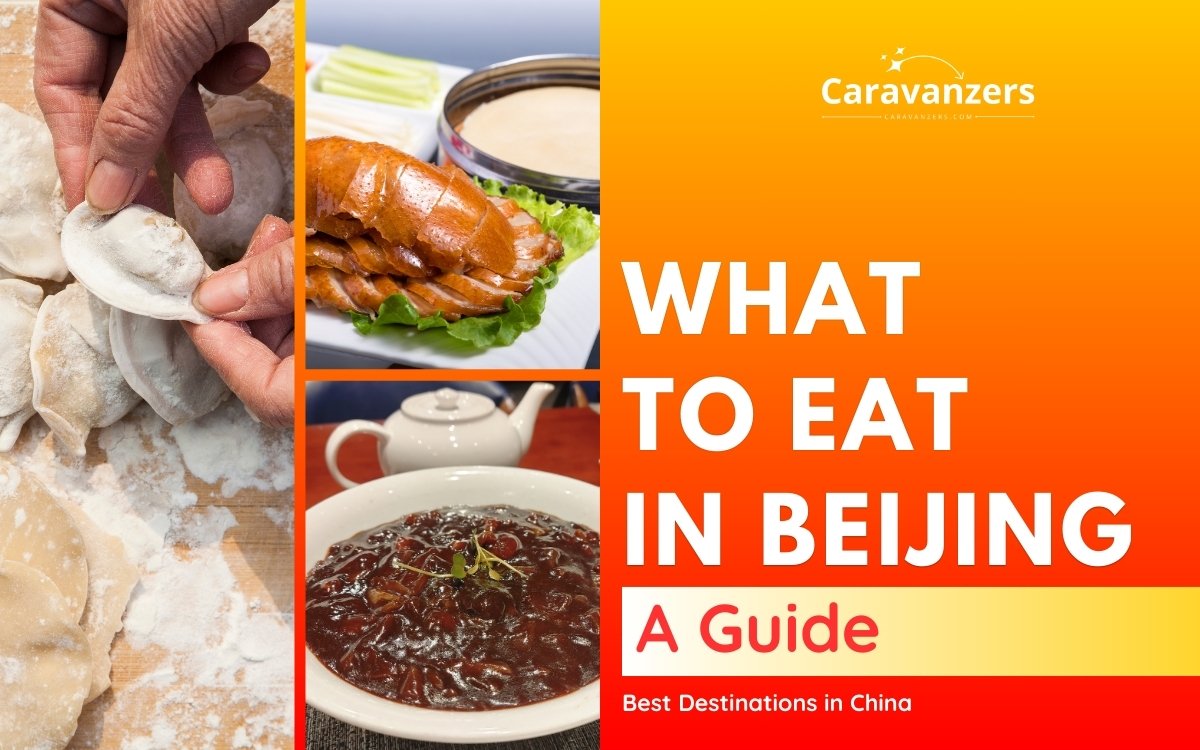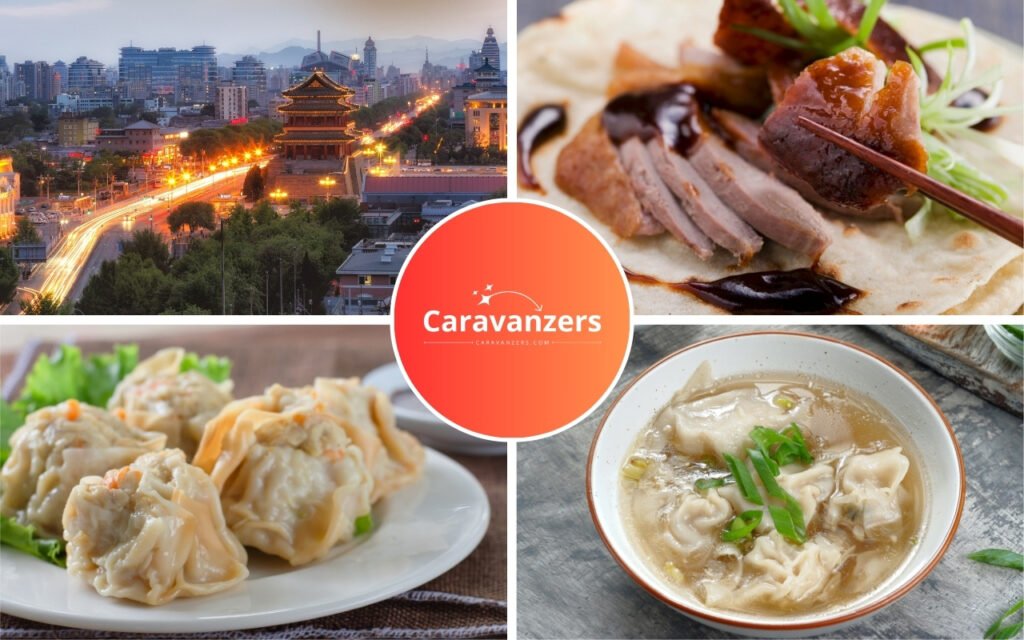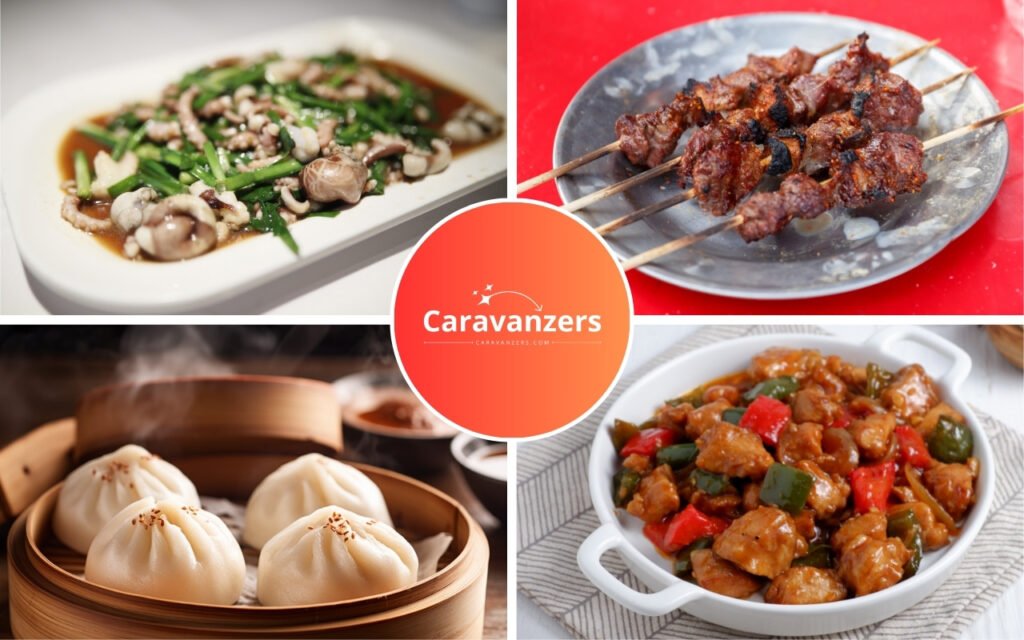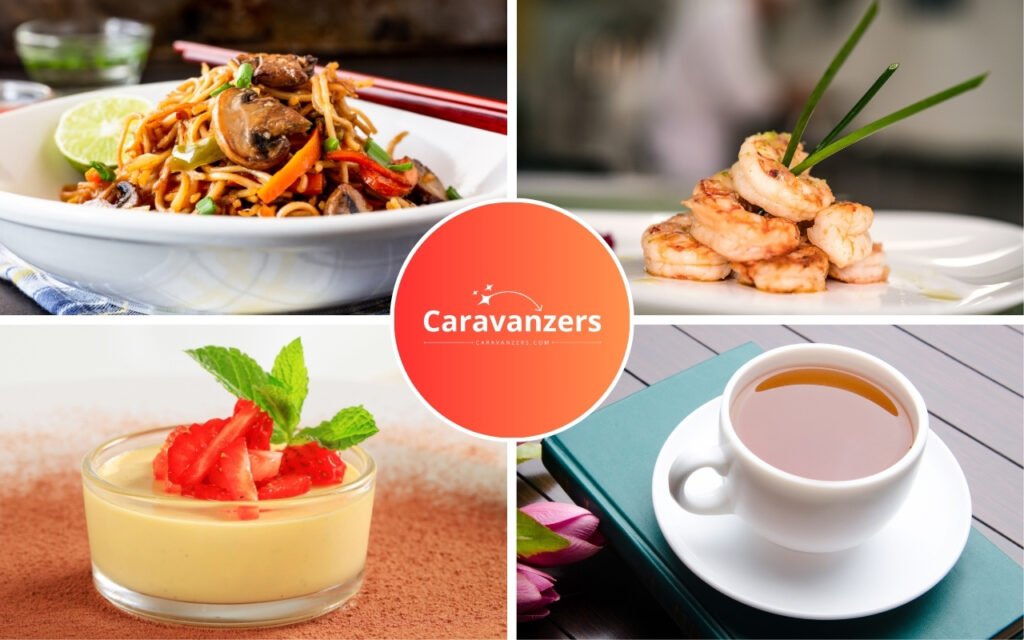
What to eat in Beijing. This guide has everything you need to know to enjoy a foodie trip to the Chinese capital.
Beijing has diverse food scene, where traditional Chinese cuisines like Shandong and Cantonese are side by side with global flavors from Europe and beyond.
Plus, the local stuff is amazing. From savory dumplings and fiery dishes, the capital has a food adventure for every type of traveler.
If you are going to Beijing soon, you will find this guide super helpful.
Beijing Food Scene
The Beijing food scene is a mix of tastes that blends the Beijinger local stuff with traditional Chinese cuisines.
Global influences also abound, giving you a chance to try Asian flavors alongside European classics.
Meanwhile, modern gastronomy thrives in the capital. There are innovative interpretations of Chinese and international fare.
So, from humble street stalls to upscale eateries, Beijing’s diverse food gives you a ton of options.
Beijinger Cuisine

Beijinger cuisine is the traditional food from this area of China. This is a cuisine famous for its array of unique snacks and dishes.
Snacks, dumplings and wontons, noodles, and a famous duck dish are all waiting for you in this cuisine.
Beijing cuisine, which by the way is sometimes called the Jing cuisine, has a diverse range of flavors.
Most people, especially foreigners, immediately note that it has bold, hearty dishes.
This is a cuisine characterized by a strong emphasis on preserving the original flavors of the ingredients used.
Rather than overpowering them with heavy seasonings or spices, the locals love to keep it as natural as possible.
Meanwhile, you will probably realize that this cuisine features a balanced and nuanced flavor profile.
It’s not as fiery as some other cuisines like Sichuan.
Instead, Beijing dishes often incorporate mild to moderate levels of seasoning, with an emphasis on savory, salty, and sometimes sweet flavors.
You will also find dishes that are aromatic, savory, and occasionally tangy. In most family recipes, there is a focus on the use of ingredients like soy sauce, vinegar, garlic, ginger, and various aromatic spices.
Here are the must-try classics to add to your list.
Fuling Jiabing (Snack)
Beijing’s Fuling Jiabing is probably the most popular street snack. It has a thin, crispy pancake exterior filled with a savory bean paste.
Fuling Jiabing (茯苓夹饼) literally means “poria cake.” Poria or tuckahoe, or even simply China root, is probably what it was originally used to make it.
Locals usually use a mixture of wheat flour, sesame seeds, and sometimes scallions to make it. The result is a crunchy texture with a hint of nuttiness.
Meanwhile, the filling consists of a seasoned mixture of mung bean paste, which is savory with a slightly sweet undertone.
When cooked, the pancake becomes golden brown and fragrant. It’s really a delightful combination of textures and flavors.
Travelers will be able to try Fuling Jiabing by visiting local markets, street food stalls, or specialty shops scattered throughout Beijing.
These snacks are often freshly made and can be enjoyed on the go while exploring the city’s bustling streets.
Beijing Jiaozi (Peking Dumplings)
Beijing’s jiaozi (北京饺子) are savory dumplings filled with a variety of ingredients such as pork, shrimp, or vegetables.
These delicious goodies are wrapped in thin dough and either boiled, steamed, or pan-fried. It depends on the accompanying foods.
Of course, the most common way is to boil, and unless you ask otherwise, that’s what you will get.
The dough is soft yet slightly chewy, while the filling bursts with savory flavors. Aromatic seasonings like ginger and garlic enhance the flavors.
The taste is a harmonious blend of textures and flavors. I would say they are delicious.
So, travelers will be able to try jiaozi at traditional restaurants, local eateries, or specialized dumpling shops throughout the city.
One great place to try is at Xian’r Lao Man (馅老满酒家) in the hutongs in Dongcheng. This is a traditional spot with an English menu. Its address is 252 Andingmen Inner.
Beijing Hundun (Peking Wonton)
Beijing’s wontons (北京馄饨) are super delicate dumplings filled with a mixture of meats.
Typically, you will find minced pork or shrimp, seasoned with ingredients like ginger, garlic, and green onions.
Wantons are wrapped in thin dough and usually boiled in a flavorful broth.
Travelers will be able to try Beijing’s wontons at local noodle shops, traditional restaurants, or street food vendors across the city.
A great place to try Beijinger wontons is at Furongji (福榮記). The Orchid Hotel in the hutongs in Dongcheng is where you will find it. This is a modern spot with English menu. Its address is 65 Baochao Hutong.
Beijing Zhajiangmian (Noodles)
Another popular Beijinger cuisine dish is Zhajiangmian ( 炸酱面). This delicious dish is thick wheat noodles topped with a savory sauce.
In most families, ground pork or beef cooked with fermented soybean paste, garlic, ginger, and other seasonings makes up the savory sauce.
Zhajiangmian means “noodles with fried bean sauce,” and, like many Beijinger recipes, Zhajiangmian’s origins go back to another area of the country. This particular dish originally came from Shandong (more about this cuisine later).
The sauce is flavorful, with a slightly salty and umami taste, while the noodles tend to have a chewy texture that complements the sauce perfectly.
Fresh cucumber slices and shredded carrots are perfect for garnishing for a refreshing crunch.
So, travelers will be able to try Zhajiangmian at local noodle shops, casual eateries, or traditional restaurants throughout Beijing.
Zhajiangmian is such a hearty and satisfying taste of Beijing’s food heritage.
A great place to try it is at the Lao Beijing Zhajiangmian (老北京炸酱面大王). The address is 9 Chongwenmenwai Dajie, in the Chongwen District, near the Temple of Heaven.
Beijing Kaoya (Peking Duck)
Beijing’s famous duck, known as “Peking Duck” in the outside world, is a masterpiece dish of the cuisine.
Beijing Duck, or Beijing Koaya ( 北京烤鸭), is a roasted duck that has crispy skin and succulent meat.
The duck is traditionally roasted in a closed oven, which results in a crispy exterior while retaining tender and juicy meat.
Unlike many Beijinger dishes, it originated right here. This dish dates back to the city’s Yuan era, although our current version was perfected during the Qing dynasty.
The taste is savory and rich, with a hint of sweetness from the marinade used before roasting. Many local families use sweet-level ingredients like apples, star anise, and cinnamon to marinate.
Served with thin pancakes, scallions, cucumber, and hoisin sauce, each bite is so delicious because of the combination of textures and flavors.
So, travelers will be able to try Beijing Duck at specialized restaurants, upscale eateries, or traditional spots.
One of the best places to try this dish is at the 1949 The Hidden City (1949隐秘的城市), a restaurant in the Chaoyang district. The address Courtyard 4, Gongti Beilu, near the famous mall Pacific Century Place.
Chinese Cuisine in Beijing

Like other global capital, Beijing has diverse food options. For example, you will find an array of traditional Chinese restaurants that serve foods from various regions.
Shandong cuisine is very popular here. This is a cuisine that tempts with delicious seafood dishes and savory braised meats.
Huaiyang cuisine is another popular dish. This one is famous for its focus on light flavors and meticulous preparation techniques.
Similarly, Xinjiang cuisine is very popular. This is a unique cuisine of Muslim background, and it has bold and aromatic flavors. It’s famous for lamb dishes.
Meanwhile, you also will get a bunch of Sichuan restaurants. This cuisine really ignites the palate with its fiery spices and numbing peppercorns.
Finally, there are also many Cantonese restaurants. This is a cuisine that impresses with its fresh seafood, dim sum, and mile but flavorful stir-fries.
Shandong Cuisine
Nearby to Beijing, it’s no wonder Shandong is the most outsider cuisine in the capital.
Signature dishes include seafood like braised abalone and sweet and sour carp. This cuisine has great seafood, thanks to its location on the coast!
You will also find a lot of savory meat dishes such as braised pork belly and crispy chicken. Its sauces are really unique for the non-seafood stuff, too.
Try it at the Feng Ze Yuan in the Xicheng District. The adress is 83 Zhushikou E St, near the Temple of Heaven.
Huaiyang Cuisine
Huaiyang cuisine originates from the Jiangsu province around the Huai River Delta. This is a cuisine famous for calm flavors, lightness, and meticulous preparation techniques.
Signature dishes include lion’s head meatballs, braised fish in soy sauce, and sweet and sour spare ribs.
The taste is nuanced, with a focus on gentle sweetness and umami. Popular ingredients include sugar, soy sauce, and rice wine.
You should visit the famous Huaiyangfu, a restaurant in Dongcheng. The address is 198 Anwai Ave, near Lama Temple.
Xinjiang Cuisine
Xinjiang cuisine come from the Xinjiang Uygur Autonomous Region in northwest China. This cuisine blends influences from Central Asian, Turkish, and Chinese traditions.
Expect bold flavors and hearty dishes, including skewered lamb kebabs, hand-pulled noodles, and fragrant pilaf rice dishes.
Spices like cumin, chili, and peppercorns infuse dishes with aromatic warmth, while unique things ghee and cardamom give it a special taste.
A great place to try this cuisine is at the Xinjiang Islamic Restaurant, in Xicheng. The adress is 7 Sanlihe Road, not too far from the Beijing Zoo.
Sichuan Cuisine
Sichuan cuisine is not just popular in Beijing but all over China and the world. It comes from the southwestern province of the same name.
This cuisine is famous for the bold flavors, fiery spices, and extra hot peppercorns in delicious dishes like mapo tofu, Kung Pao chicken, and hot pot.
I would say the taste is intense, with a unique combination of spiciness, numbness, and depth of flavor.
There are so many places to try this across Beijing, but I would highly recommend Chuanban, run by the province government for authenticity. Its address is 5 Gongyuantou Aly, in Dongcheng.
Cantonese Cuisine
Cantonese cuisine originates from Guangdong province in southern China. This is a cuisine popular everywhere because thanks to Hong Kong and San Francisco.
Expect fresh ingredients, calm flavors, and meticulous preparation techniques. It’s one of the calmest cuisines in all of Asia.
Dishes are typically seafood, dim sum, and stir-fries, with a balance of sweet, savory, and umami flavors.
Signature dishes include dim sum classics like steamed dumplings and barbecue pork buns. You will also get seafood specialties like steamed fish and crispy roast duck.
The overall taste is refined, with a focus on natural flavors and subtle seasoning.
A great place to try Cantonese food is at the Tang Palace in Dongcheng. The address is 17 Jiannei Ave, near the Museum of Women and Children.
Global Cuisines in Beijing

Beijing is a world-class city, and the capital of one of the most important countries today. As a result, expect to find a lot of international eateries.
For example, non-Chinese Asian cuisines have a diverse range of options, from Japanese sushi and ramen to Korean barbecue and Thai curries.
Likewise, European cuisine is also well-represented, with French bistros, Italian trattorias, and Spanish tapas bars serving up classics.
Similarly, Beijing has cultivated a thriving gourmet scene with innovative fusion restaurants, modern bistros, and upscale fine dining establishments.
In other words, don’t worry, this is not a city where you will be forced to eat the same things again and again.
Finally, I expect to spend a lot of time in the Chaoyang District, where there are a lot of international restaurants.
Asian Food
Non-Chinese Asian cuisines have a mix of flavors from across the continent, and you will enjoy as much as you want in Beijing.
Let’s start with our favorite Asian country, Japan. Japanese sushi bars will serve you fresh sashimi and uniquely rolled sushi. Ramen shops are famous for their comforting bowls of noodles in savory broth.
In my opinion, Songyuan Japanese Cuisine is one of the best Japanese restaurants. The address is 35 E Chang’an St, near the Forbidden City.
Of course, Korean culture has always been part of Beijing. Korean barbecue joints sizzle with grilled meats, served with an array of banchan side dishes.
For the most amazing diverse food, visit the Zixia Gate Korea Restaurant in Chaoyang. The address is 201 Huguang N St, near Beixiaohe Park.
Meanwhile, Beijingers also love Thai food. Thai restaurants will definitely give you a unique taste with delicious spicy curries and aromatic stir-fries.
I would say a popular place to try Thai is at the Very Siam, a restaurant in Chaoyang. The address is 10A Xinyuan Xili Dongjie.
Finally, if you love Indian food, check out Ganges Indian Restaurant in Chaoyang. Curries, biryanis, samomas, and more. The address is 9 Guanghua Rd, near the Temple of the Sun.
European Food
Restaurants that serve up European cuisines in Beijing have an array of dishes from all over the continent.
Start with French bistros, which exude charm with classics like coq au vin and boeuf bourguignon.
A popular French restaurant is Les Morilles, in Chaoyang. Expect modern French cuisine. The address is 37 Maizidian Street, in the Beijing Sunflower Tower.
Likewise, Italian trattorias in Beijing will tempt you with hearty pasta and wood-fired pizzas.
A great place to try this cuisine is Tavola Italian Dining in Chaoyang. If you love pizza, they have delicious ones. The address is 19 Dongfang E Road, near Chaoyang Park.
Meanwhile, there are also plenty of Spanish tapa bars in Beijing that invite you to share plates. Expect delicious bites of patatas bravas and jamón ibérico, and yummy sweet wines.
I really like Carmen Tapas Bar & Restaurant in Chaoyang. It’s really a fun place. The adress is 81 Sanlitun Bar Street.
Beijingers also love German beer halls for some reason. They tend to have hearty sausages and schnitzel.
If you want really delicious German food, visit Schindler’s Tankstelle in Chaoyang. The address is 15 Guanghua Road, near the Temple of the Sun.
Finally, Beijingers go crazy for British pubs, and these places tend to serve up traditional fish and chips.
If you want to try something unique, visit Molly Malone’s in Dongcheng. They actually have good burgers. Its address is 90 Jinbao St, not too far from the Forbidden City.
Gourmet Food

In Beijing, the gourmet scene is a playground for food innovation and indulgence. Upscale restaurants and avant-garde bistros push the boundaries of taste and presentation.
Wutai Yun Organic and Vegan Restaurant, for example, serves famous Chinese dishes in a non-traditional way. Their vegan hotpot, for example, is super popular.
If you like vegan food, their address is 54 Jiaoda E Rd, in Haidian.
Interestingly enough, some traditional cuisines have gotten into gourmet games, too. Xin Rong Ji is a good example.
With a pretty modern take on Taizhou food from the Zhejiang province, Xin Rong Ji’s modern presentation of traditional food has led to Michelin stars.
Duck with fish maw and taro? Yes. Visit their flagship restaurant at 8 Xinyuan South Road, in Chaoyang.
Other times, Beijinger gourmet spots create inventive fusion dishes that marry Eastern and Western flavors.
Korean and Mexican fusion? Why not! That’s exactly what Palms L.A. Kitchen and Bar does. You will be obsessed with their Korean BBQ tacos.
Palms L.A. Kitchen and Bar’s address is 14 Zhangwang Hutong, in Dongcheng.
So, yeah, that will definitely give you a good taste of gourmet food in Beijing.
What to Avoid
While Beijing has amazing food, there are a few things to be cautious of during your trip. The last thing you need is to get sick.
First of all, avoid consuming tap water and ice cubes to prevent potential stomach upset.
The ice is very tricky because you will order something and not realize, so be careful where you order food.
And always ask!
Likewise, exercise caution when eating street food. This is because you could end up eating from unhygienic vendors.
Please, make sure to check everything, including the cleanliness of how the food is made or served, to avoid foodborne illnesses.
Meanwhile, be wary of overly oily or heavily spiced dishes, as they may not agree with everyone’s palate.
I mentioned earlier that Sichuan is a super spicy cuisine. So, if you find yourself ordering something at a hole in the wall, ask for milder serving.
Also, be cautious with unfamiliar seafood dishes to avoid potential allergic reactions.
Finned fish, which is one of the most common food allergies in Western countries, is very popular in China.
Unfortunately, you may not even know there are fish products in the dish! So, make sure to ask.
Finally, if you have dietary restrictions or preferences, communicate them clearly to make your meals meet your needs.
Enjoy your food in Beijing!
Li Xiu Ying is a travel writer and is the author of Beijing Travel. She writes about China for Caravanzers.
Follow us on Pinterest.
